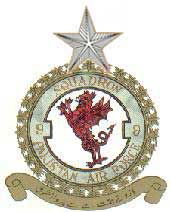|
The story of No 9 Squadron dates back to May 1944 when it made its operational debut in Burma during WW II. Equipped with Hurricane II C aircraft, it engaged in extensive operations in that theatre and was awarded a souvenir Japanese general's sword in recognition of its meritorious services. In the years that followed, the squadron maintained itself in a high state of combat preparedness on a succession of the latest fighter aircraft of their time: Spitfire VIII, Tempest 11, Fury, Starfighter, Mirage, and most recently, the Fighting Falcon. Five of its squadron commanders - M Asghar Khan, A Rahim Khan, Zafar A Chaudhry, Zulfiqar Ali Khan and Jamal A Khan - rose to lead the Pakistan Air Force. Originally raised at Risalpur on 13 November 43, the squadron was allotted to the RPAF upon partition at the instance of Squadron Leader Asghar Khan, who had commanded it in 1945 and was a member of the Air Force Reconstitution Committee in July 47. In its new capacity as the first fighter squadron of the RPAF, it was formed at Peshawar on 15th August 1947 with 8 Tempest aircraft under the command of Squadron Leader M Ibrahim Khan. After flying Tempests for almost three years, the squadron converted onto the Hawker Fury fighters in July 50. In November 56, the unit moved to Kohat which was to become its home for the next five years. In 1961, the squadron's decade-long association with Furies as well as its piston-engined chapter came to an end. In March 61 came the F-104 Starfighters - the ultimate in aircraft technology at that time. In the PAF, 9 Squadron was the only recipient of this awe inspiring Mach 2 fighter which, through its sheer power and speed, struck terror in enemy ranks in both the India-Pakistan Wars. The Starfighters, after rendering valuable service for more than a decade, faded out of Pakistani skies in the early 70s.
No 9 Squadron reemerged at Rafiqui in January 1973 as a tactical attack unit, equipped with brand new Mirage-V aircraft. On 15 June 77, it became an OCU with the task of converting pilots onto Mirage fighters. On 31st August 1981, it moved to PAF Masroor and remained there till the middle of 1984. As an OCU, the squadron graduated 15 conversion courses on Mirages and in June 84, the squadron changed its location once again and moved to Sargodha, where it was reequipped with F-16 Fighting Falcons and was redesignated as No 9 Multi-Role Squadron. It was on this aircraft that Squadron Leader Hameed Qadri shot down an Afghan Air Force Su-22 and damaged another while flying an air defence mission over Parachinar on 17 July 86.
9 Squadron's record in war has been as striking as its achievements in peacetime. In the 1965 war it flew air defence, fighter escort and recce missions from the city of Shaheens on its fabled Starfighters. On 6th September Flight Lieutenant Aftab shot down an IAF Mystere which was attacking Rahwali. On the 7th Flight Lieutenant Amjad H Khan accounted for another Mystere. Squadron Leader Jamal A Khan intercepted and shot down 1 IAF Canberra at night. For their acts of valour Squadron Leaders Jamal A Khan and M. L.Middlecoat and Flight Lieutenant Amjad H Khan were decorated with Sitara-i-Juraat.
Soon after the start of the 1971 war the Squadron flew its Starfighters to PAF Masroor. There, while performing air defence day/night strikes, recce and escort duties, its pilots shot down an Indian Gnat, a Su-7 and an Alize. Squadron Leader Amjad H Khan ejected in Indian territory while attacking a radar and was taken prisoner of war. Wing Commander M L Middlecoat and Flight Lieutenant Samad Changezi made the supreme sacrifice by laying down their lives in defence of the fatherland; both Shaheeds were posthumously awarded the Sitara-i-Juraat.
For its meritorious services in war and peace, the squadron was awarded the squadron colour on 25th January 1979. The scrolls around the squadron crest in the middle of the banner carry the battle honours: 'Sargodha 65' and 'Karachi 71'. The squadron crest itself is a griffin; a mythical creature with an eagle's head and wings and a lion's body signifying immeasurable strength, aggressiveness and vigilance.
|

